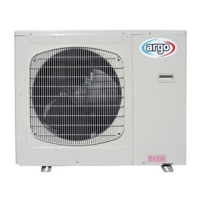5
2-2. Outdoor Unit
AVOID:
● heat sources, exhaust fans, etc. (Fig. 3)
● damp, humid or uneven locations.
DO:
● choose a place as cool as possible.
● choose a place that is well ventilated.
● allow enough room around the unit for air intake/
exhaust and possible maintenance. (Fig. 4a)
● provide a solid base (level concrete pad, concrete
block, 15 × 40 cm beams or equal), a minimum of
15 cm above ground level to reduce humidity and
protect the unit against possible water damage and
decreased service life. (Fig. 4a)
● install cushion rubber (not provided) under unit’s
feet to reduce vibration and noise. (Fig. 4b)
● use lug bolts or equal to bolt down unit, reducing
vibration and noise.
● select a location where the operating noise and air
blowing from the outdoor unit will not disturb neigh-
bors.
● select a location where the clearance indicated by
⇔ in the installation diagram is ensured for the
front, rear, left, and right of the main unit.
● install so that the unit is level.
● select a location that can fully support the weight of
the outdoor unit, and that will not magnify operating
noise or vibration.
(Fasten in place with the anchor bolts (M10).)
● provide a base using concrete or similar material,
and ensure proper drainage.
● select a location where there is no danger of
flammable gas leakage.
● in snowy or rainy regions, be sure to construct a
roof to keep off the snow and rain, and inhibit freez-
ing and condensation.
● select a location that is at least 3 meters away from
any antennas used for television, radio transceiver,
or other equipment.
● for purposes of future service and repair, select a
location where the inspection panel can be removed.
● select a location where the drain port will not be
obstructed.
Min.
Min.
Min.
Min. 20 cm
Min. 15 cm
Install the inter-unit cable more than 1 meter away
from any antenna or power lines or connecting wires
used for television, radio, telephone, security system,
or intercom. Electrical noise from any of these
sources may affect operation.

